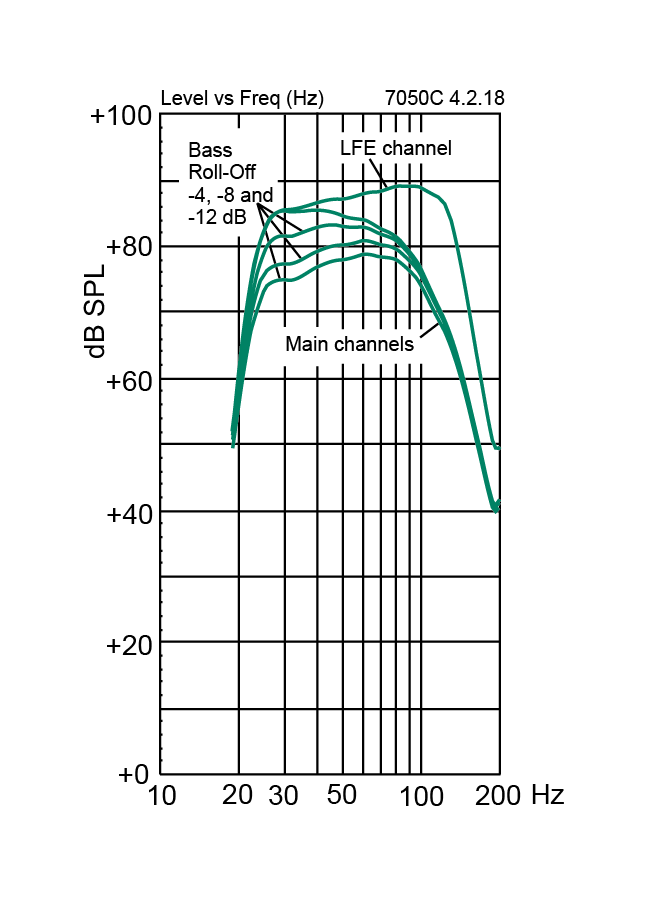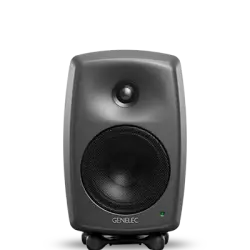För de som behöver en kompakt subbas med utökad LF-prestanda, generös SPL och professionell bass-management är 7050C det självklara valet.
7050C
Studio Subbas

Aktiva delningsfilter

Bass Management

SPL
103 dB

Frekvensomfång
24 Hz - 85 Hz (-6 dB)

Mått
H 410 x W 350 x D 319 mm, (vy i tum)

Det perfekta paret
7050C är den perfekta partnern för alla närfältsmonitorer, särskilt våra egna modeller 8010, 8020 och 8030. 7050C har massor av förbättringar jämfört med föregångarna i A- och B-serien, inklusive inbyggd bass-management, lägre distorsion, en universell strömadapter och en utökad högsta SPL på 103 dB.

Stereo eller multikanal
Med fem in- och utgångskanaler med 85 Hz-filtrering – plus en LFE-ingång på 120 Hz – är 7050C lika lämplig för stereo- som för multikanalarbete. Dess laminerade spiralkabinett ger utökad LF-återgivning ner till 24 Hz med imponerande låg distorsion. DIP-switcharna på bakpanelen reglerar subbasens fas och lågfrekvensfilter, aktiverar LFE-nivån över 10 dB samt aktiverar och reglerar ISS-strömsparlägets känslighet.

SPL
103 dB

Förstärkareffekt
130 W Bass (Class D)

Frekvensomfång
24 Hz - 85 Hz ("-6 dB")

Storlek på högtalarelement
⌀ 205 mm Bass (vy i tum)

Mått
H 410 x W 350 x D 319 mm, (vy i tum)

Vikt
17.3 kg / 38.1 lb

Anslutningar
6 x XLR Analog Input
5 x XLR Analog Output
7050C Studio Subwoofer
Studio Subbas
Tekniska Specifikationer
För de som behöver en kompakt subbas med utökad LF-prestanda, generös SPL och professionell bass-management är 7050C det självklara valet.

Specifikationer för system
Frekvensomfång
Low cutoff -6 dB
24 Hz
High cutoff -6 dB
85 Hz

SPL
Short term max SPL Maximum short term sine wave SPL output averaged from 30 to 85 Hz, measured in half space at 1 meter.
≥103 dB
Egenljud
Egenljud Self generated noise level in half space at 1 m on axis (A-weighted).
≤5 dB SPL
Vikt
Vikt17.3 kg (38.1 lb)
Mått
Höjd
410 mm
Bredd
350 mm
Djup
319 mm

Kabinett
Material för kabinett
MDF
Typ av kabinett
Reflex port
Högtalarelement
Typ av element
Cone
Magnetically shielded driver.
Diameter
205 mm
Harmonisk distorsion
Avsnitt Förstärkare
Förstärkare
130 W Class D
Nätspänning
100-240 VAC 50/60Hz
Strömförbrukning
ISS Aktiverat
≤0.5 W
Inaktiv
≤11 W
Full effekt
150 W
Avsnitt Signalbehandling
Anslutningar
6 x Input 5 x input connectors XLR female, 10 kOhm balanced.
1 x LFE IN connector.
5 x Output XLR male output connectors.
Produktvarianter
Produktkoder
För mer ingående teknisk information vänligen se produktens bruksanvisning
Nyckelteknologier

Aktiva delningsfilter

Bass Management

Tekniken Laminar Spiral Enclosure (LSE™)

Skyddskretsar

Optimerade förstärkare

Rumskorrigering
Aktiva delningsfilter vid låga signalnivåer.

Elektroniska delningsfilter gör det möjligt att dela upp ljudsignalen i separata frekvensband som kan dirigeras till enskilda slutsteg, vilka sedan kopplas till specifika givare som är optimerade för ett specifikt frekvensband.
Aktiva delningsfilter finns både i digitala och analoga varianter. Genelecs digitala aktiva delningsfilter har extra funktioner för signalbearbetning, såsom skydd av element, fördröjning och utjämning.
Genelecs analoga aktiva delningsfilter innehåller elektroniska komponenter som används vid låga signalnivåer som är lämpliga för ineffekten till slutstegen. Detta till skillnad från passiva delningsfilter som används vid höga signalnivåer från slutstegets uteffekt, vilket gör att de måste hantera höga strömstyrkor och i vissa fall även hög spänning.
I ett vanligt tvåvägssystem behöver de aktiva delningsfiltren två slutsteg – ett för baselementet och ett för diskantelementet.
Designen med aktiva delningsfilter har flera fördelar:
– Frekvensgången blir oberoende av eventuella dynamiska förändringar i elementets elektriska egenskaper eller nivå.
– Ökad flexibilitet och precision för att finjustera den utgående frekvensgången för de specifika elementen.
– Varje element har ett eget slutsteg och egen signalbearbetning. Detta isolerar varje element från de signaler som hanteras av övriga element, vilket minskar problemen med intermoduleringsdistorsion och förvrängning.
– Möjlighet att kompensera för känslighetsvariationer mellan elementen.
– Möjlighet att kompensera för avvikelser i frekvens- och fasåtergivning som är kopplade till elementets egenskaper inom det avsedda passbandet.
– Den platta frekvensgång som en högkvalitativ aktiv högtalare ger är resultatet av den kombinerande effekten av delningsfilterresponsen, slutstegsresponsen och elementresponsen i ett högtalarkabinett.
Genom att använda en aktiv teknik kan man justera frekvensgången och optimera hela högtalarsystemet i olika miljöer utan att behöva använda dyra externa equalizers. Slutresultatet är ett enklare, mer tillförlitligt, effektivt, konsekvent och precist aktivt högtalarsystem.
Bass Management hanterar lågfrekvenserna i multikanalsformat.

Principen för Bass Management är att basen från huvudkanalerna och lågfrekvenskanalen (Low Frequency Effect – LFE) endast riktas och återges av högtalare med kapacitet att hantera dem, oavsett om de är huvudhögtalare eller en eller flera subwoofers.
Vid stereoåtergivning måste signaler från 20 Hz till 20 kHz spelas upp. Stora flervägssystem kan ge en jämn återgivning av en så pass stor bandbredd. Med multikanalsljud måste både professionella system och system för hemmabruk kunna återge ljud mellan 20 Hz och 20 kHz för varje kanal. För att uppnå detta måste huvudhögtalare, subwoofers och delningskretsar samspela.
Ett Bass Management system använder antingen analoga elektriska kretsar eller mjukvarubaserad filtrering som filtrerar lågfrekvenser från huvudkanalerna och förmedlar informationen till en eller flera subwooferströmmar.
Den dedikerade LFE-kanalen kan också styras via subwoofern och adderas till lågfrekvenserna från de andra huvudkanalerna. Bass Management grundläggande och huvudsakliga syfte är därmed att säkerställa att hela bandbredden från alla kanaler kan återges.

Fördelar med Bass Management:
– Subwoofern utökar systemets frekvensgång ner till de lägsta gränserna av spektrumet för hörbart ljud.
– Högtalaren kan ge en högre maximal ljudnivå när den inte återger lågfrekvenser.
– Optimerad lågfrekvensåtergivning med hjälp av korrekt placering av subwoofern. Även monitorhögtalarna kan placeras mer fritt.
– Subwooferns uteffekt är justerad med avseende till nivå och fas med monitorhögtalare som levererar rak och precis återgivning ner till 19 Hz och över delningsfrekvensen.
– LFE-kanalens uteffekt (0 eller +10 dB avseende huvudkanalerna) kan väljas för precis återgivning beroende på typ av källa.
– Möjligheten att förbikoppla subwoofern gör det möjligt att utvärdera dess ljudpåverkan.
Den otroligt effektiva tekniken Laminar Spiral Enclosure (LSE™) ger korrekt återgivning av lågfrekvenser.

Kraven på subwoofers har ökat betydligt de senaste åren, vilket har lett till att traditionella designkoncept inte längre är effektiva. För Genelec innebär detta att vi måste ta djärva initiativ för att uppnå absolut högsta prestanda.
Efter många års forskning och expertis insåg Genelecs ljudtekniker att det fanns nya utmaningar att ta tag i under 2000-talet. Den unika, böjda formen på kabinettet till aktiva subwoofers i LSE™-serien är det revolutionerande, patenterade resultatet av vårt hårda arbete.
Alla subwoofers i LSE™-serien från Genelec har det innovativa basreflexkabinettet Laminar Spiral Enclosure™ (LSE™). Konstruktionen ger ett utomordentligt laminärt flöde med minimalt turbulensljud och optimal placering av ett långt reflexrör i ett litet utrymme.

Principerna från LSE-tekniken används även i utformningen av reflexporten i våra aluminiumkabinett.
Den spiralformade designen ger en otroligt stabil kabinettexteriör samtidigt som den formar subwooferns reflexport. Tack vare den integrerade designen kan luften både in och ut genom kabinettet genom den spiralformade porten flöda helt fritt. Detta ger ett utomordentligt precist och följsamt lågfrekvenssystem med uppmätt nivå av andra och tredje ordningens harmonisk distorsion som vanligtvis är bättre än 30 dB under grundtonen.

I kombination med Genelecs aktiva elektroniska komponenter för bass-management för stereo- eller multikanalsljud ger våra subwoofers i LSE™-serien lågfrekvenslyssning som inte kan fås någon annanstans. Resultatet är en produktserie med överlägsen teknisk prestanda: Genelecs LSE-serie med subwoofers är unik, komplett och ger konsekvent prestanda som inte liknar några andra produkter på marknaden.
Sofistikerade skyddskretsar för drivenheter för säker användning.

När du arbetar med avancerad ljudproduktion är det otroligt viktigt att dina monitorsystem alltid är tillförlitliga och fungerar som de ska. Det främsta skälet till Genelecs framgångar inom sändningstillämpningar är våra produkters tillförlitlighet, och en viktig faktor bakom detta är de interna skyddskretsarna som finns i alla våra produkter – ända sedan 1978.
Skyddskretsarna förebygger fel på elementet genom att analysera signalnivåerna. Vid plötsliga toppar eller för höga nivåer under en längre tid minskas signalnivån automatiskt. Den här funktionen påverkar givetvis inte ljudkvaliteten på något sätt när högtalaren används inom ramen för dess specifikationer. Den hindrar endast avvikande ingångssignaler från att orsaka skada på högtalaren.

Skyddskretsarnas funktioner och fördelar:
– Minskar uteffektnivån vid behov (t.ex. när temperaturen vid elementets talspole uppnår ett gränsvärde), vilket förbättrar systemets tillförlitlighet betydligt
– Lämpliga skyddskretsar i alla högtalare och subwoofers gör det möjligt att maximera systemets utgående ljudnivå.
Varje givare drivs av en egen optimerad förstärkare.

Elektroniska delningsfilter gör det möjligt att dela upp ljudsignalen i separata frekvensband som kan dirigeras till enskilda slutsteg, vilka sedan kopplas till specifika givare som är optimerade för ett specifikt frekvensband.
I ett vanligt tvåvägssystem behöver det aktiva delningsfiltret två slutsteg – ett för baselementet och ett för diskantelementet. Slutstegen är direkt kopplade till den aktiva högtalarens element, vilket gör att slutstegens belastning blir mycket enklare och välkänd. Varje elementspecifikt slutsteg har endast en begränsad frekvens att förstärka (slutsteget är placerat efter det aktiva delningsfiltret), vilket bidrar till att göra designen enkel.
Den aktiva designprincipen har flera fördelar:
– Slutstegen är direkt kopplade till högtalarens element, vilket maximerar kontrollen som utövas av slutstegens dämpning på elementets talspole. Detta reducerar i sin tur följderna av dynamiska förändringar i elementets elektriska egenskaper. Detta kan förbättra systemets transienta svar.
– Minskning av den uteffekt som krävs från slutsteget. Tack vare att ingen energi går förlorad i komponenterna till det passiva delningsfiltret minskas den uteffekt som krävs från slutsteget betydligt (med upp till 50 % i vissa fall), utan någon minskning av den akustiska uteffekten i högtalarsystemet. Detta kan bidra till att sänka kostnader och öka både ljudkvaliteten och systemets tillförlitlighet.
– Ingen förlust mellan förstärkaren och elementenheterna, vilket leder till maximal akustisk effektivitet.
– Den aktiva tekniken kan uppnå överlägsen ljudprestanda vs. storlek vs. lägre frekvensgräns.
– Alla högtalare levereras som ett fabrikskonfigurerat system (förstärkare, delningsfilterkomponenter, kabinett och elementsystem).
Precis rumskorrigering för optimering av högtalarprestandan i ditt rum.

Interaktionen mellan rummets akustik och högtalarens ljudspridning är komplex. Alla rum påverkar monitorhögtalarens återgivning på något sätt, till exempel reflekterande rum jämfört med ljudisolerade rum och placering av högtalarutrustning vid väggen eller på avstånd från väggen.
Alla högtalare från Genelec har rumskorrigeringsalternativ som kan användas för att kompensera för rummets påverkan på akustiken och uppnå en platt frekvensgång vid lyssningspositionen.
Analoga system
Genelecs analoga högtalare har mångsidiga rumskorrigeringsalternativ. Här ingår (beroende på modell):
– Lågfrekvensfilter och -lutning
– Diskantfilter och -lutning
– Basnivå
– Mellanregisternivå
– Diskantnivå
– Desktop Control

För lågfrekvenser finns två huvudsakliga styrningsalternativ. Baslutningskontrollen fungerar som ett shelving-filter tillsammans med lågfrekvensfiltret som gör det möjligt för dig att optimera systemets låga och riktigt låga frekvensgång i olika installationer. Styrningsalternativ för bas, mellanregister och diskant finns för de större systemen. Dessa styrningsalternativ gör det möjligt att optimera den relativa balansen mellan de olika passbanden.
Användarmanualen och databladet för varje högtalare innehåller en lista över de rekommenderade rumskorrigeringsinställningarna för olika installationer. De har tagits fram utifrån lång praktisk erfarenhet och mätningar av olika typer av vanliga akustiska miljöer.
Smart Active Monitor-system (SAM™)
Genelecs SAM-system erbjuder ett omfattande och lösningsinriktat produktsortiment med smarta anslutningsmöjligheter där alla produkter har programvaran Genelec Loudspeaker Manager (GLM™) och dess system för automatisk kalibrering, AutoCal™.
AutoCal från Genelec ger dig möjlighet att för första gången genomföra en integrerad process för fullständigt automatiserad mätning, analys och justering av alla monitorhögtalare i GLM-nätverket. Systemet mäter återgivningen i lyssningsområdet och tillämpar lämplig kompensering för lågfrekvenserna och låg- till mellanfrekvenserna för att minimera negativ akustisk påverkan från rummet samt skillnaderna mellan olika lyssningspositioner. AutoCal justerar även relativa nivåer, löptid och korrekt delningsfas (AutoPhase) för alla subwoofers i systemet.

Programmet Acoustic Response Editor visar den uppmätta återgivningen, filterkompenseringen och den resulterande systemåtergivningen för varje monitorhögtalare i diagram med full manuell kontroll över de akustiska inställningarna.
Referenser
Hitta Din Återförsäljare

Dokumentation
Dokument
Operating Manual 7050C Quick Setup Guide 7050C Brochure 7050C Genelec Home Studio Audio Monitoring Guide (2023) Classic Active Monitoring Series Catalogue 2018 Genelec 7050C Operating Manual - Chinese Genelec Home Studio Audio Monitoring Guide (German version)FAQ
Connecting the 7050B Subwoofer
The 7050B subwoofer has balanced XLR IN/OUT connector pairs for five main channels and a dedicated LFE input connector for the LFE channel. Connect the signal cables from your source to the female XLR "IN" connectors on the lower connector row. Next connect XLR cables from the corresponding "OUT" male XLR connectors on the upper row to the input connectors of each 8020C monitor.
Turn the volume control knob on all 8020C’s monitors fully clockwise and switch the "Bass Roll-off" dip switch (switch 2) on all 8020C’s to "ON". This switch actuates an 85 Hz high-pass filter on the 8020C’s matching them to the main channel low-pass filter of the 7050B.
Alternatively you can connect to the 7050B a stereo pair of 8020C monitors by routing the signal cables from the source to the input connectors of the main monitors and an another pair of cables from the main monitors' output connectors to the "IN" connectors on the 7050B. In this configuration the volume controls on the main monitors affect the playback level of the 7050B too. The "Bass Roll-off" switch on the main monitors must also be switched to "ON" (switch 2).

Why to Align a Multichannel System?
The main goal in the alignment of a multichannel system is to set the subwoofer output level the same as the sound output level of the main monitor system. The LFE output of the mixing desk or decoder should be connected to the LFE input on the subwoofer.
For the 7050B, 7060B, 7070A, 7071A, 7073A products:
The LFE input has the same sensitivity as all other signal inputs unless the ‘LFE +10 dB’ DIP switch is ON. The switch is used when there is no +10 dB gain in the LFE channel output. The switch is set to 0 dB when there is already a +10 dB additional gain in the LFE channel output.
What reference level to use?
To ensure repeatable results in the finished product, the SMPTE (Society of Motion Pictures and Television) has set standard monitoring levels for cinema post-production work. The SMPTE reference level at the listening position is 85 dB SPL, on C weighted/slow scale. The input signal to the monitors is -20 dB FS (rms) full bandwidth pink noise. The SMPTE RP200 uses an electrical reference level of -18 dB FS.
For music mixes, there are no standardized levels. The level that the engineer chooses is arbitrary and based on personal taste, as is the level chosen by the end user. The level is typically 75 dB SPL for television audio work and 75-95 dB SPL for music production work.
Manual calibration of the level and frequency response
Monitors are first calibrated to have flat response at the listening position. This is achieved by doing the following:
Calibrate the monitor frequency responses using an acoustical measuring system with the subwoofer bypassed or disconnected. Then connect the Genelec subwoofer and adjust the subwoofer level, bass roll-off and phase so that the measured combined frequency response of the subwoofer and the monitor extends flat to the LF cut-off of the subwoofer, paying special attention to the subwoofer to monitor crossover point.
Alternative level calibration methods
If acoustic measurement system is not available for aligning the system, then follow the guidelines that can be found in the operating manual for adjusting the frequency response:
Level calibration using a ⅓ octave real time analyzer, broadband pink noise and an SPL meter
Connect the Genelec 5.1 system and play broadband pink noise signal (20 Hz – 20 kHz) through the subwoofer and one of the monitors, for example the centre channel monitor. Adjust the acoustic settings in the subwoofer and monitors so that the level in each band on the RTA analyser reads the same value. Then, set the output level of each channel to give the same acoustical level at the listening position.
Level calibration using filtered pink noise and an SPL Meter
You need to have filtered pink noise to calibrate the levels of the subwoofer and the main channels. You can use a copy of the TMH Corporation 'Multichannel Studio Test Tape' that includes the various test signals required.
Pink noise filtered to a passband 500 Hz to 2 kHz is used for adjusting the monitor levels, and between the frequency range 20 Hz to 80 Hz is used for calibrating the subwoofer level. Please note: If the standard recorded level of filtered pink noises is -18 dBFSrms for SMPTE RP200's (-20 dBFSrms for SMPTE) and then the absolute level calibration can be made so that the sound level meter reads a level 2 dB lower than specified for broadband pink noise. This is because there is less energy due to band limiting of the band-pass noise.
- Connect to monitors and play the 500 Hz to 2 kHz filtered pink noise. Set the SPL Meter to C-weighting and slow reading. Adjust each main channel individually to have the same SPL level at the listening position.
- Play 20 to 80 Hz filtered pink noise through the subwoofer. The correct adjustment gives a reading 3dB lower than the one for the monitors because the C weighting lowers the reading in the SPL meter at those frequencies. If there is no HP filter in the SPL meter then the reading should be the same as for the monitors.
hello
Got Questions?
Search our support portal for articles on frequently asked questions:
You can also submit an enquiry to our customer support team here.










































